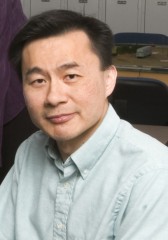
Ant Behavior Insights for Enhanced Electronics Design

Virginia Tech
Virginia Tech engineer Michael Hsiao has developed mathematical formulas that simulate the methods used by the ants when they are seeking nourishment. Hsiao plans to use these algorithms to improve the accuracy in electronics design.
Ant colonies are known for their efficiency in finding the best route to food sources. So Hsiao, professor of electrical and computer engineering at Virginia Tech, and an expert in design verification has tackled one of the major problems facing electronics design in a novel way.
He has developed mathematical formulas that simulate the methods used by the ants when they are seeking nourishment.
Hsiao plans to use these algorithms to improve the accuracy in electronics design when one needs to validate and verify that the design meets the spec.
The National Science Foundation has awarded him a grant of $418,345 to continue exploring his ideas.
Hsiao explained that as electronics designers add more features and capabilities into ever-smaller electronics hardware, such as the latest versions of cell phones, they are increasing the difficulty of verifying that their designs perform as planned.
Verification difficulty grows exponentially as the design grows in size, according to Hsiao. “A poorly verified design compromises both the system’s reliability and its security,” he added.
In electronics design, the verification problems have grown so large that the International Technology Roadmap for Semiconductors has reported that “verification engineers significantly outnumber designers” on current projects, increasing costs significantly.
The challenge is in exploring an exponential-sized search space, which in the worst case involves searching all the possible states in the circuit. Since traditional, single perspective approaches are not keeping up with the growing complexity, Hsiao plans to apply intelligence from multiple perspectives at the same time.
His grant from the National Science Foundation will allow him to integrate a swarm intelligence strategy developed in his laboratory with multiple abstract models, parallel processing, and general-purpose graphics processing units (GPUs).
In large and complex search spaces, many of the conventional techniques often encounter tremendous difficulties, he said, “because either the small single abstract model is insufficient or the computational cost of formal/semi-formal learning becomes infeasible.”
The swarm-intelligent framework at the heart of Hsiao’s approach is based on long-term research he has conducted using algorithms that simulate the methods used by ant colonies to find the most efficient route to food sources.
This Ant Colony Optimization method involves employing an automatic stimuli generator on the design to create a database of possible vectors, which are then populated by a swarm of intelligent agents. Like real ants, these intelligent agents deposit a pheromone along their paths that attract other agents. The pheromone evaporates over time, resulting in a reinforcement of the most efficient pathways, allowing for the aggregation of knowledge gained from a large number of agents.
“In this regard, the proposed swarm-intelligent framework emphasizes the effective modeling and learning from collective effort by extracting the intelligence acquired during the search over multiple abstract models,” Hsiao said.
The simulation loops through multiple runs. The branches with the highest fitness values are removed so the system can focus on the rarely visited branches — an elegant way of finding and testing the “hard corners” that can be so hard to verify and validate in a design.
The computational efficiency of this approach “is a vast improvement over other methods, covering a far higher percentage of possible states in far less time.” Hsiao said.
This research should lead to a better understanding of the validation of large, complex designs and help cut the overall cost of the design process. “The success of this project not only will push the envelope on design validation, but will also offer new stimuli generation methods to related areas, such as post-silicon validation and validating trust of hardware,” Hsiao said.
Contact Information
Lynn Nystrom
Director of News
tansy@vt.edu









![[Figure 1] Schematic of next-generation CNT-PANI composite fiber supercapacitor and comparison graph with recent results](https://www.innovations-report.com/wp-content/uploads/2025/05/KIST_leads_next-generation_energy_storage_technolo_1746783279-e1746784635527-362x245.jpg)


